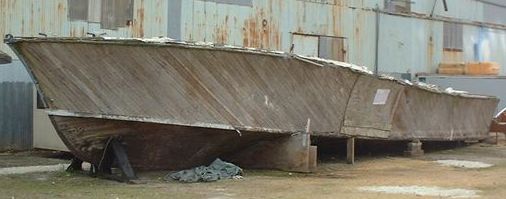HSL-142 - 63 FT HIGH SPEED LAUNCH
 |
| PRINCIPAL PARTICULARS: |
| Type: |
63 ft BPB High Speed Launch |
| Service: |
RAF |
| Builders: |
British Power Boats |
| Year Built: |
1941 |
| Number Built: |
69 |
| Displacement: |
21.5 tons |
| Length: |
63 ft |
| Beam: |
17½ ft |
| Draught: |
3¾ ft |
| Hull: |
Mahogany |
| Engines: |
3 x Napier Sea Lion 500hp |
|

HSL 142 hull May 2004 - awaiting a decision on her future |
The BPB 63ft High Speed Launch was the second design from the company and was often referred to as the BPB Type Two HSL. Otherwise it was known as the WHALEBACK from its distinctive curved hull and humped cabin. The design was an adaptation of an existing craft that was in production by BPB for the Royal Navy as MASB's. The HSL retained the same engines as the "Type One", (See HSL 102) namely Napier Sea Lion petrol engines, however as the craft were introduced after WWII had commenced, they were armed from the outset. The craft were employed around the UK coasts including the Channel and North Sea operating from bases such as Dover. Several craft were lost in the Channel, enemy action accounting for the loss of 11 craft in total world-wide. The 63ft HSL's were also shipped out to the Mediterranean for use there and later to India. The craft were a vast improvement over the 64ft HSL's, also from BPB.
The weapons carried by the 63ft HSL varied, but initially were single .303 Vickers or Lewis guns in each turret. After several boats were attacked, the armament was increased to twin Vickers on free mountings added on each side of the wheelhouse plus a 20mm Oerlikon cannon mounted aft. Browning 0.5 machine guns were sometimes carried on free mountings.
69 craft were produced for the RAF between 1940 and 1942, the first - HSL141- was BPB Yard No. 1477. The first batch were all built at Hythe and the craft 141 - 149 were originally for the SAAF and were ordered prior to HSL 122-140, but taken over after the first RAF order. Of the second batch of 35 craft, HSL 156-190, all were built at Hythe except nine which were built at the Poole yard. The last batch of six craft were probably ordered in late 1941. After WWII, several craft were disposed of, however 5 were handed over to the Italian Air Force, a total of 10 were earmarked for conversion to Target Towing Launches, but the conversions were not carried out. One craft, HSL 168, was converted to a Remote Control Target Launch, and was the last Whaleback to be disposed of in 1950. Three of the 63ft HSLs were transferred to RN control and given RN Boat Numbers.
The vast majority of the 63ft HSL's were however transferred to the Admiralty for subsequent disposal after the end of the hostilities. The craft were laid up in storage at places such as Calshot and Dumbarton and sold off. Of these at least nine survived to become houseboats etc., however none have been preserved in original condition and none are known to be held by Museums, thus the presence of HSL 142 at Marchwood, hopefully to be restored to her original appearance, is very important.
The hull of the 63ft HSL was hard chine, with skin constructed in double diagonal African mahogany, 4in x ½in planks with a layer of proofed canvas between. Planks were through fastened by clenched copper rivets and attached to frames by brass screws. Hull sides, transom, bottom and decking were all of similar construction. Frames were African mahogany with rock elm facings. The stem was spruce, shaped and fastened to the keel by spruce deadwood. All bulkheads were of special light weight fabrication to a Power Boat patent. The wheelhouse and cabin were prefabricated synthetic resin bonded plywood with spruce frames and stiffeners. The hull was sub-divided into six watertight compartments by five bulkheads. Under the wide foredeck and abaft the forepeak was the crew's mess, with bunks and a galley fitted with a pressurised paraffin oven. Forward of the mess against the fore peak bulkhead was the crew's Baby Blake toilet and washbasin to port with a chain locker and a ladder leading up to a hatch to starboard. Aft of the crew's mess on the starboard side, steps led up to the wheelhouse and a level deck led aft under the conning position to a chart room and sick bay. The latter could accommodate five stretchers. Leading off from the chart room on the starboard side was a small wireless cabin aft of which was a double berth cabin for NCO's, whereas on the port side of the chart room was a single cabin for the Captain. Access to the forward turret, offset to port, was also in the chart room. The main engine fuel tanks were situated underneath the deck of the sick bay. Stretcher access to the sick bay was via a wide hatch on the port side of the casing. The aft turret access was also right aft in the sick bay section.
Go to page 2
|
|